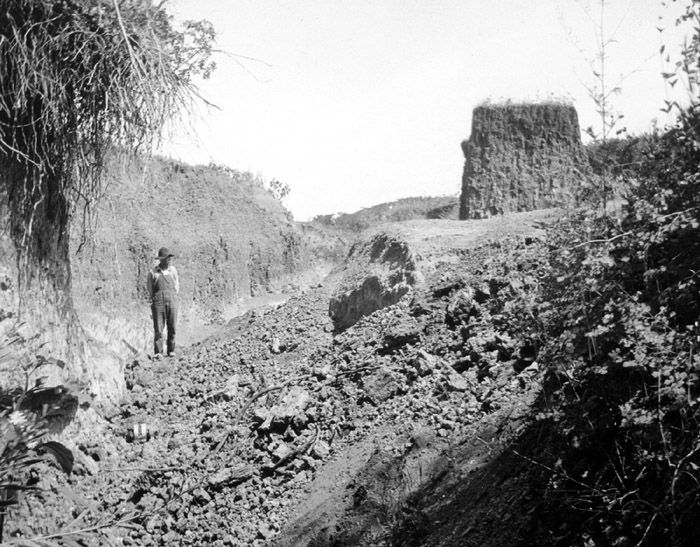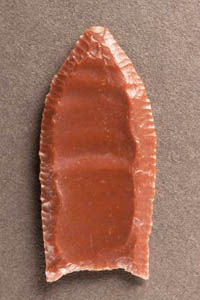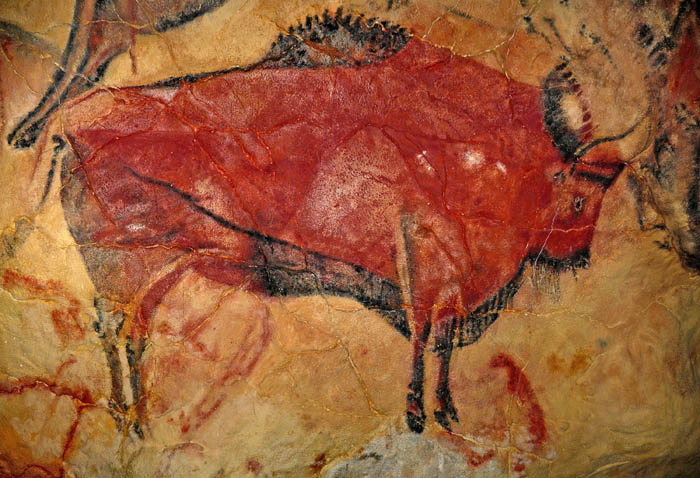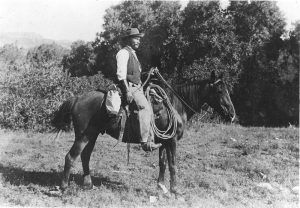The Folsom Culture is a Paleo-Indian archaeological period that occupied much of central North America between 9000 BC and 8000 BC. Thought to have derived from the earlier Clovis culture, the groups differentiated by a specific and unique stone tool-making technology.
The culture is associated with early Paleoindian hunter-gatherers of the Great Plains, Rocky Mountains, and American Southwest. The Clovis people were primarily mammoth hunters, an economy that was much more widespread than Folsom. When the mammoth died off, people in the southern Plains developed new points to exploit bison. The use of Folsom points as projectile tips and activities is known from kill sites where slaughter and butchering of bison took place, and Folsom tools were left behind.
Like Clovis points, Folsom points were likely attached to darts and delivered by atlatl throwing sticks. These leaf-shaped tips with fluted sides were required because bison are faster and weigh much less than mammoths. Folsom artifacts also include a variety of scrapers, knives, and blades.
Relying on bison for most of their food, clothing, and shelter needs, Folsom bison hunter-gatherers lived in small, highly mobile groups, following the migration patterns of the herds. They probably traveled across large areas during hunting season before settling down for part of the year where resources could be found, such as stone, wood, water, and plants. The Folsom diet also included smaller game such as mountain sheep, marmots, deer, and rabbits.
The Folsom Site, near Folsom, New Mexico, was first discovered by George McJunkin in 1908. An African American cowboy and former slave who had lived in Texas as a child, he made his way to New Mexico in 1858, where he became a ranch foreman. Later he became a buffalo hunter and worked for several ranches in Colorado, New Mexico, and Texas. He then settled down again near Folsom, New Mexico, where he worked as a foreman on the Crowfoot Ranch.
After a tragic flood in Folsom in August 1908 that killed 18 people, McJunkin assessed the damage at the Crowfoot Ranch. While working on a fence, he entered an arroyo where he discovered remains of several giant prehistoric bison exposed by the flood. Among the bison bones was a distinctive type of stone tool, now called a Folsom point. Recognizing the find’s significance, McJunkin left the site undisturbed, except for recovering a few sample points.
In the following years, he tried to interest archaeologists to no avail until he sent sample bones and a lance point to the Denver Museum of Natural History in 1918. The museum then sent paleontologist Harold Cook to investigate the site the following spring. Though some McJunkin and Cook did some exploratory digging, a thorough excavation did not occur until 1926, after McJunkin’s death.

A flash flood in 1908 exposed the archaeological site near Folsom, New Mexico. The site was named for the nearby town of Folsom, New Mexico.
At that time, the remains of Giant Bison at the site were found to have gone extinct at the end of the last Ice Age. This showed that people had inhabited North America since at least 9000 BC, some 7000 years earlier than previously thought. The bison kill site showed evidence that 32 bison were trapped and killed at Folsom, and distinctive stone projectile points and tools were found. In 1917, Jesse Dade Figgins, director of the Colorado Museum of Natural History, first used the term “Folsom culture” to refer to the people who made and used the artifacts.
Since then, many other sites have been found, with some showing evidence of up to 50 bison being killed. Other flaked-stone tools include end and side scrapers, finely pointed gravers, and bifacial knives. Rare bone artifacts include eyed needles and beads.
Thousands of Folsom points from more than 1,500 sites have been documented. The site distribution reaches from Alberta and Saskatchewan, Canada to Chihuahua, Mexico, and southern Texas, and from eastern Oregon and eastern Arizona on the west to Minnesota, Wisconsin, Illinois, western Indiana, and the eastern parts of Missouri, Nebraska, Oklahoma, and Texas on the east.
Folsom sites include camps, bison kills, butchery sites, and stone quarries. Most of the sites are small in size and in the number of artifacts they contain, except for the Lindenmeier Site in Colorado, which was used throughout a longer period. The numbers of bison represented in most kill sites also tend to be small, containing the remains of 5-8 bison. However, the Lipscomb site in Texas contained the remains of over 50 bison.

Folsom Point courtesy Colorado Encyclopedia
Colorado: Barger Gulch, Stewart’s Cattle Guard, Lindenmeier, Linger, Mountaineer, Reddin
Montana: Indian Creek
New Mexico: Blackwater Draw, Folsom, Rio Rancho
North Dakota: Big Black, Bobtail Wolf, Lake Ilo
Oklahoma: Cooper, Jake Bluff, Waugh
Texas: Chispa Creek, Debra L. Friedkin, Hot Tubb, Lake Theo, Lipscomb, Lubbock Lake, Scharbauer, Shifting Sands
Wyoming: Agate Basin, Carter/Kerr-McGee, Hanson, Hell Gap, Rattlesnake Pass
©Kathy Alexander/Legends of America, December 2021.
Also See:
Ancient Cities of Native Americans
George McJunkin – Black Cowboy & History Changing Amateur Archaeologist
Native American Archaeological Periods
Sources:


